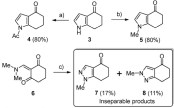
Synthesis and SAR Analysis of Novel 4-Hydroxytamoxifen Analogues Based on Their Cytotoxic Activity and Electron-Donor Character
The paper authored by C. Duró, T. Jernei,
K. J. Szekeres,
G. G. Láng,
R. Oláh-Szabó, Sz. Bősze, I. Szabó, F. Hudecz and A. Csámpai
is published in Molecules (2022, vol. 27, pp. 6758).
Abstract:
Utilizing McMurry reactions of 4,4′-dihydroxybenzophenone with appropriate carbonyl compounds, a series of 4-Hydroxytamoxifen analogues were synthesized. Their cytotoxic activity was evaluated in vitro on four human malignant cell lines (MCF-7, MDA-MB 231, A2058, HT-29). It was found that some of these novel Tamoxifen analogues show marked cytotoxicity in a dose-dependent manner. The relative ROS-generating capability of the synthetized analogues was evaluated by cyclic voltammetry (CV) and DFT modeling studies. The results of cell-viability assays, CV measurements and DFT calculations suggest that the cytotoxicity of the majority of the novel compounds is mainly elicited by their interactions with cellular targets including estrogen receptors rather than triggered by redox processes. However, three novel compounds could be involved in ROS-production and subsequent formation of quinone-methide preventing proliferation and disrupting the redox balance of the treated cells. Among the cell lines studied, HT-29 proved to be the most susceptible to the treatment with compounds having ROS-generating potency.
